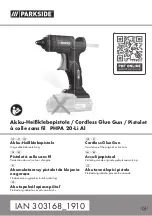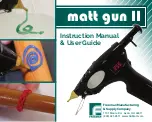
-9-
TOOL OPERATION
EYE PROTECTION which conforms to ANSI specifications and provides protection against
flying particles both from the FRONT and SIDE should ALWAYS be worn by the operator and
others in the work area when connecting to air supply, loading, operating or servicing this
tool. Eye protection is required to guard against flying fasteners and debris, which could
cause severe eye injury.
The employer and/or user must ensure that proper eye protection is worn. Eye protection
equipment must conform to the requirements of the American National Standards Institute,
ANSI Z87.1 and provide both frontal and side protection.
NOTE: Non-side shielded spectacles and face shields alone do not provide adequate
protection.
CAUTION: Additional Safety Protection will be required in some environments. For
example, the working area may include exposure to noise level which can lead to hearing
damage. The employer and user must ensure that any necessary hearing protection is
provided and used by the operator and others in the work area. Some environments will
require the use of head protection equipment. When required, the employer and user must
ensure that head protection conforming to ANSI Z89.1 is used.
BEFORE HANDLING OR OPERATING THIS TOOL:
I. READ AND UNDERSTAND THE WARNINGS CONTAINED IN THIS MANUAL.
II. REFER TO "TOOL SPECIFICATIONS" IN THIS MANUAL TO IDENTIFY THE
OPERATING SYSTEM ON YOUR TOOL.
OPERATION
1. CONTACT TRIP OPERATION:
The CONTACT TRIP is a contact trip that operates in conjunction with the trigger to drive a fastener. There
are two methods of operation to drive fasteners with a contact trip tool.
A. SINGLE FASTENER PLACEMENT: To operate the tool in this manner, first position the contact trip on
the work surface, WITHOUT PULLING THE TRIGGER. Depress the contact trip until the nose touches
the work surface and then pull the trigger to drive a fastener. Do not press the tool against the work
with extra force. Instead, allow the tool to recoil off the work surface to avoid a second unwanted
fastener. Remove your finger from the trigger after each operation.
B. RAPID FASTENER OPERATION: To operate the tool in this manner, hold the tool with the contact trip
pointing towards but not touching the work surface. Pull the trigger and then tap the contact trip against
the work surface using a bouncing motion. Each depression of the contact trip will cause a fastener to
be driven.
The operator must not hold the trigger pulled on contact trip tools except during fastening
operation, as serious injury could result if the trip accidentally contacted someone or
something, causing the tool to cycle.
Keep hands and body away from the discharge area of the tool. A contact trip tool may
bounce from the recoil of driving a fastener and an unwanted second fastener may be
driven, possibly causing injury.
2. SEQUENTIAL TRIP OPERATION:
The SEQUENTIAL TRIP is a contact trip that operates in conjunction with the trigger to drive a fastener.
To operate a sequential trip tool, first position the contact trip on the work surface WITHOUT PULLING
THE TRIGGER. Depress the contact trip and then pull the trigger to drive a fastener. As long as the
contact trip is contacting the work and is held depressed, the tool will drive a fastener each time the trigger
is depressed. If the contact trip is allowed to leave the work surface, the sequence described above must
be repeated to drive another fastener.
Sequential Trip Operation
Contact Trip Operation

























